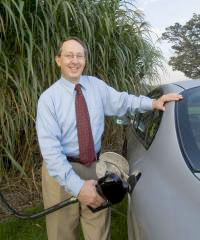Jan 19 2009
Publications ranging from the journal Science to Time magazine have blasted biofuels for significantly contributing to greenhouse gas emissions, calling into question the environmental benefits of making fuel from plant material. But a new analysis by Michigan State University scientists says these dire predictions are based on a set of assumptions that may not be correct.
 Bruce Dale is a cellulosic ethanol researcher at Michigan State University
Bruce Dale is a cellulosic ethanol researcher at Michigan State University
"Greenhouse gas release from changes in land use – growing crops that could be used for biofuels on previously unfarmed land – has been identified as a negative contributor to the environmental profile of biofuels," said Bruce Dale, MSU University Distinguished Professor of chemical engineering and materials science. "Other analyses have estimated that it would take from 100 to 1,000 years before biofuels could overcome this 'carbon debt' and start providing greenhouse gas benefits."
But as Dale and his co-authors point out in their research, published in the January online edition of the journal Environmental Science & Technology, earlier analyses didn't consider a number of variables that might influence the greenhouse gas emissions associated with biofuels.
"Our analysis shows that crop management is a key factor in estimating greenhouse gas emissions associated with land use change associated with biofuels," Dale said. "Sustainable management practices, such as no-till farming and planting cover crops, can reduce the time it takes for biofuels to overcome the carbon debt to three years for grassland conversion and 14 years for temperate zone forest conversion."
The discrepancies between the time it will take biofuels to offer environmental benefits is due to the models used for each analysis, Dale explained.
"There are no real data on what actually happens as demand increases for land for biofuel production in one part of the world potentially leads to land clearing, because it is impossible to track these relationships in the real world," Dale said. "All the estimates are based on economic relationships and theoretical models with various data and assumptions. It's really one set of assumptions versus another set. The other scientists believe their assumptions are more reasonable, and we believe ours are more reasonable.
"How land is managed after it's converted to cropland is very important," Dale continued. "The authors of the Science paper assumed the worst-case scenario – plow tillage – which we don't think is accurate. The actual use of sustainable management practices – no till, reduced till and other approaches – is more than 50 percent and increasing."